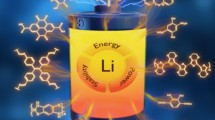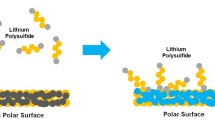Abstract
The high demands on lithium-ion batteries (LIBs) have increased concern about novel carbon nanomaterials with high capacity and cycling stability. Herein, twisted carbonaceous nanoribbons with high BET specific surface area of 1413 m2 g−1 were successfully synthesized using twisted 4, 4′-biphenylene bridged polybissilsesquioxane tubular nanoribbons as the starting material. Electrochemical measurement showed that the carbonaceous nanoribbon electrode not only delivered a high specific capacity of 921.1 mAh g−1 after 250 cycles at a current density of 0.1 A g−1, but also exhibited superior cycling stability and excellent rating capability. The work presents a facile way to design and fabricate good anode candidate for LIBs.








Similar content being viewed by others
References
Abbas S, Ali S, Niaz N, Ali N, Ahmed R, Ahmad N (2014) Superior electrochemical performance of mesoporous Fe3O4/CNT nanocomposites as anode material for lithium ion batteries. J Alloys Compd 611:260–266
Armand M, Tarascon J (2008) Building better batteries. Nature 451:652–657
Bruce P, Scrosati B, Tarascon JM (2008) Nanomaterials for rechargeable lithium batteries. Angew Chem Int Ed 47:2930–2946
Chan C, Ruffo R, Hong S, Huggins R, Cui Y (2009) Structural and electrochemical study of the reaction of lithium with silicon nanowires. J Power Sources 189:34–39
Cheng J, Wang B, Park CM, Wu Y, Huang H, Nie F (2013) CNT@Fe3O4@C coaxial nanocables: one-pot, additive-free synthesis and remarkable lithium storage behavior. Chem Eur J 19:9866–9874
Chen LF, Huang ZH, Liang HW, Gao HL, Yu SH (2014) Three-dimensional heteroatom-doped carbon nanofiber networks derived from bacterial cellulose for supercapacitors. Adv Funct Mater 24:5104–5111
Chen X, Yang S, Motojima S, Ichihara M (2005) Morphology and microstructure of twisting nano-ribbons prepared using sputter-coated Fe-base alloy catalysts on glass substrates. Mater Lett 59:854–858
Chen Z, Cao Y, Qian J, Ai X, Yang H (2010) Antimony-coated SiC nanoparticles as stable and high-capacity anode materials for Li-ion batteries. J Phys Chem C 114:15196–15201
Dahn J, Zheng T, Liu Y, Xue J (1995) Mechanisms for lithium insertion in carbonaceous materials. Science 270:590–593
Huang X, Qi X, Boey F, Zhang H (2012) Graphene-based composites. Chem Soc Rev 41:666–686
Idota Y, Kubota T, Matsufuji A, Maekawa Y, Miyasaka T (1997) Tin-based amorphous oxide: a high-capacity lithium-ion-storage material. Science 276:1395–1397
Jia S, Song T, Zhao B, Zhai Q, Gao Y (2014) Dealloyed Fe3O4 octahedra as anode material for lithium-ion batteries with stable and high electrochemical performance. J Alloys Compd 617:787–791
Kim B, Uono H, Satou T, Fuse T, Ishihara T, Ue M, Senna M (2005) Cyclic properties of Si-cu/carbon nanocomposite anodes for Li-ion secondary batteries. J Electrochem Soc 152:A523–A526
Laruelle S, Grugeon S, Poizot P, Dolle M, Dupont L, Tarascon J (2002) On the origin of the extra electrochemical capacity displayed by MO/Li cells at low potential. J Electrochem Soc 149:A627–A634
Lee SH, Sridhar V, Jung JH, Karthikeyan K, Lee YS, Mukherjee R, Koratkar N, Oh IK (2013) Graphene-nanotube-iron hierarchical nanostructure as lithium ion battery anode. ACS Nano 7:4242–4251
Li H, Li B, Chen Y, Zhang M, Wang S, Li Y, Yang Y (2009) Preparation of chiral 4,4 '-biphenylene-silica nanoribbons. Chin J Chem 27:1860–1862
Liu H, Li Z, Liang Y, Fu R, Wu D (2015) Facile synthesis of MnO multi-core@nitrogen-doped carbon shell nanoparticles for high performance lithium-ion battery anodes. Carbon 84:419–425
Liu J, Liu XW (2012) Two-dimensional nanoarchitectures for lithium storage. Adv Mater 24:4097–4111
Liu S, Duan Y, Feng X, Yang J, Che S (2013) Synthesis of enantiopure carbonaceous nanotubes with optical activity. Angew Chem Int Ed 52:6858–6862
Liu Y, Huang K, Luo H, Li H, Qi X, Zhong J (2014) Nitrogen-doped graphene-Fe3O4 architecture as anode material for improved Li-ion storage. RSC Adv 4:17653–17659
Reddy M, Ryu S, Shanmugharaj A (2016) Synthesis of SnO2 pillared carbon using long chain alkylamine grafted graphene oxide: an efficient anode material for lithium ion batteries. Nanoscale 8:471–482
Roberts A, Li X, Zhang H (2014) Porous carbon spheres and monoliths: morphology control, pore size tuning and their applications as Li-ion battery anode materials. Chem Soc Rev 43:4341–4356
Sato K, Noguchi M, Demachi A, Oki N, Endo M (1994) A mechanism of lithium storage in disordered carbons. Science 264:556–558
Shao C, Zhang F, Li B, Li Y, Wu QH, Yang Y (2017) Helical mesoporous carbon nanoribbons as high performance lithium ion battery anode materials. J Taiwan Inst Chem Eng 80:434–438
Sun H, Wang Q, Geng H, Li B, Li Y, Wu QH, Fan J, Yang Y (2016) Fabrication of chiral mesoporous carbonaceous nanofibers and their electrochemical energy storage. Electrochim Acta 213:752–760
Suzuki M, Yumoto M, Kimura M, Shirai H, Hanabusa K (2004) New low-molecular-mass gelators based on L-lysine: amphiphilic gelators and water-soluble organogelators. Helv Chim Acta 87:1–10
Wang C, Li Y, Ostrikov K, Yang Y, Zhang W (2015a) Synthesis of SiC decorated carbonaceous nanorods and its hierarchical composites Si@SiC@C for high-performance lithium ion batteries. J Alloys Compd 646:966–972
Wang F, Song R, Song H, Chen X, Zhou J, Ma Z, Li M, Lei Q (2015b) Simple synthesis of novel hierarchical porous carbon microspheres and their application to rechargeable lithium-ion batteries. Carbon 81:314–321
Wang HG, Wu Z, Meng FL, Ma DL, Huang XL, Wang LM, Zhang XB (2013a) Nitrogen-doped porous carbon nanosheets as low-cost, high-performance anode material for sodium-ion batteries. Chemsuschem 6:56–60
Wang K, Li Z, Wang Y, Liu H, Chen J, Holmes J, Zhou H (2010) Carbon nanocages with nanographene shell for high-rate lithium ion batteries. J Mater Chem 20:9748–9753
Wang Q, Chen H, Li B, Li Y, Yang Y (2014) Single-handed helical carbonaceous bundles prepared using a chiral polybissilsesquioxane. Mater Lett 128:279–283
Wang SX, Yang L, Stubbs L, Li X, He C (2013b) Lignin-derived fused electrospun carbon fibrous mats as high performance anode materials for lithium ion batteries. ACS Appl Mater Interfaces 5:12275–12282
Wang W, Sun Y, Liu B, Wang S, Cao M (2015c) Porous carbon nanofiber webs derived from bacterial cellulose as an anode for high performance lithium ion batteries. Carbon 91:56–65
Wu X, Ji S, Li Y, Li B, Zhu X, Hanabusa K, Yang Y (2009a) Helical transfer through nonlocal interactions. J Am Chem Soc 131:5986–5993
Wu Y, Wei Y, Wang J, Jiang K, Fan S (2013) Conformal Fe3O4 sheath on aligned carbon nanotube scaffolds as high-performance anodes for lithium ion batteries. Nano Lett 13:818–823
Wu Z, Pang J, Lu Y (2009b) Synthesis of highly-ordered mesoporous carbon/silica nanocomposites and derivative hierarchically mesoporous carbon from a phenyl-bridged organosiloxane. Nanoscale 1:245–249
Xing W, Bai P, Li Z, Yu R, Yan Z, Lu G, Lu L (2006) Synthesis of ordered nanoporous carbon and its application in Li-ion battery. Electrochim Acta 51:4626–4633
Xin S, Guo YG, Wan LJ (2012) Nanocarbon networks for advanced rechargeable lithium batteries. Acc Chem Res 45:1759–1769
Yang X, Wei C, Sun C, Li X, Chen Y (2017) High performance anode of lithium-ion batteries derived from an advanced carbonaceous porous network. J Alloys Compd 693:777–781
Yang Y, Suzuki M, Owa S, Shirai H, Hanabusa K (2007) Control of mesoporous silica nanostructures and pore-architectures using a thickener and a gelator. J Am Chem Soc 129:581–587
Yan Y, Tang H, Wu F, Xie Z, Xu S, Qu D, Wang R, Wu F, Pan M, Qu D (2017) Facile synthesis of Fe2O3@graphite nanoparticle composite as the anode for Lithium ion batteries with high cyclic stability. Electrochim Acta 253:104–113
Yi J, Li X, Hu S, Li W, Zhou L, Xu M, Lei J, Hao L (2011) Preparation of hierarchical porous carbon and its rate performance as anode of lithium ion battery. J Power Sources 196:6670–6675
Zhang C, Li Y, Li B, Yang Y (2013) Preparation of single-handed helical carbon/silica and carbonaceous nanotubes by using 4,4 '-biphenylene-bridged polybissilsesquioxane. Chem Asian J 8:2714–2720
Zhang F, Wang KX, Li GD, Chen JS (2009) Hierarchical porous carbon derived from rice straw for lithium ion batteries with high-rate performance. Electrochem Commun 11:130–133
Zhang W, Yin J, Lin Z, Lin H, Lu H, Wang Y, Huang W (2015) Facile preparation of 3D hierarchical porous carbon from lignin for the anode material in lithium ion battery with high rate performance. Electrochim Acta 176:1136–1142
Funding
This work was supported by the National Natural Science Foundation of China (No. 21574095 and 51473106), and the Priority Academic Program Development of Jiangsu High Education Institutions (PAPD).
Author information
Authors and Affiliations
Corresponding author
Ethics declarations
Conflict of interest
The authors declare that they have no conflict of interest.
Additional information
Publisher’s note
Springer Nature remains neutral with regard to jurisdictional claims in published maps and institutional affiliations.
Rights and permissions
About this article
Cite this article
Wang, HR., Cai, WJ., Yang, YG. et al. Twisted carbonaceous nanoribbons as high-performance anode material for lithium-ion batteries. J Nanopart Res 21, 62 (2019). https://doi.org/10.1007/s11051-019-4505-6
Received:
Accepted:
Published:
DOI: https://doi.org/10.1007/s11051-019-4505-6




